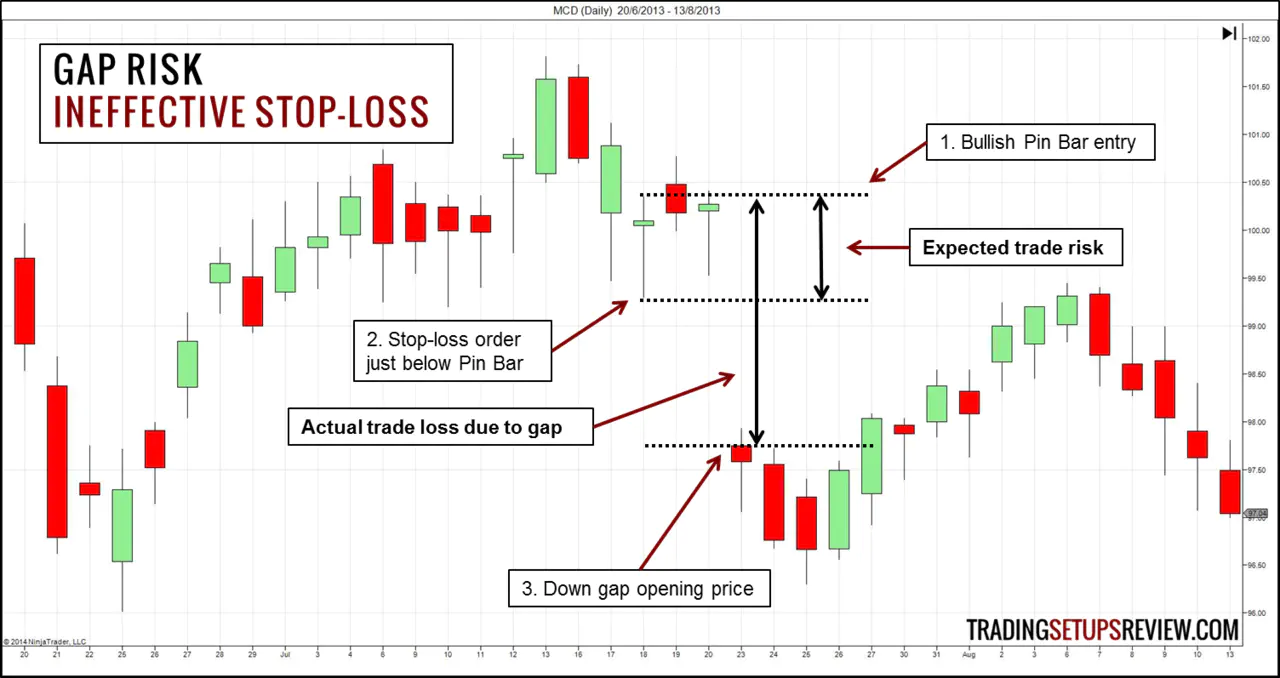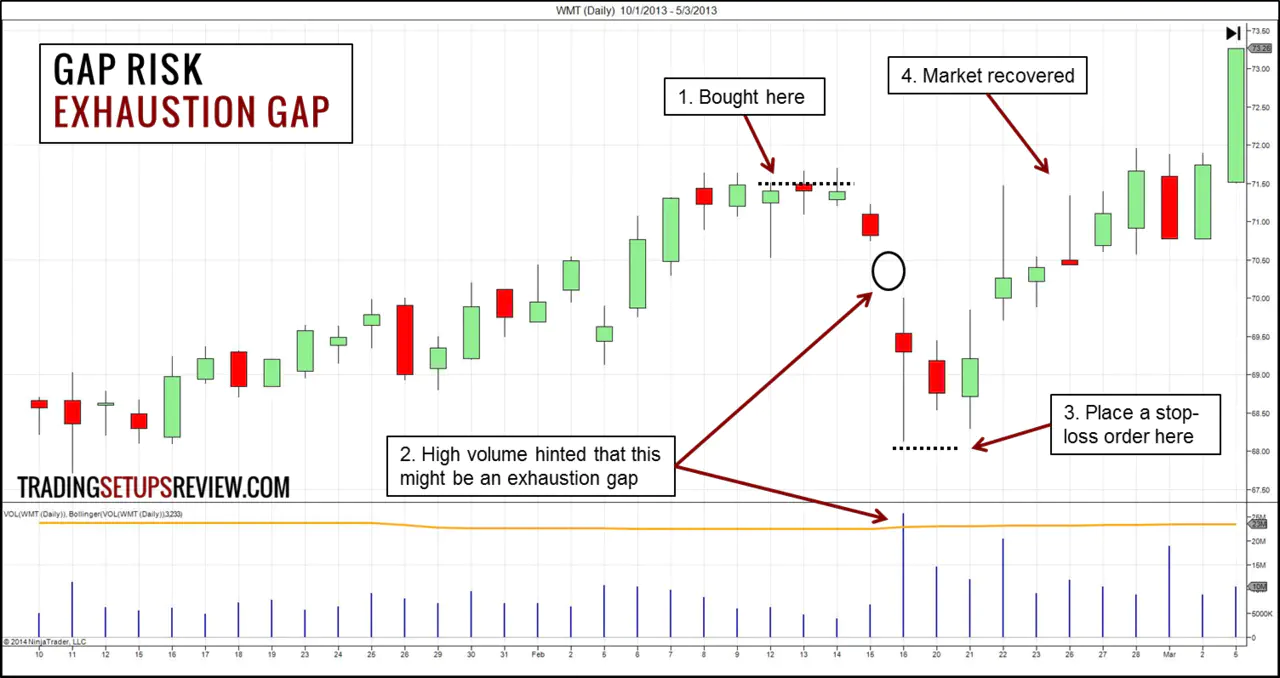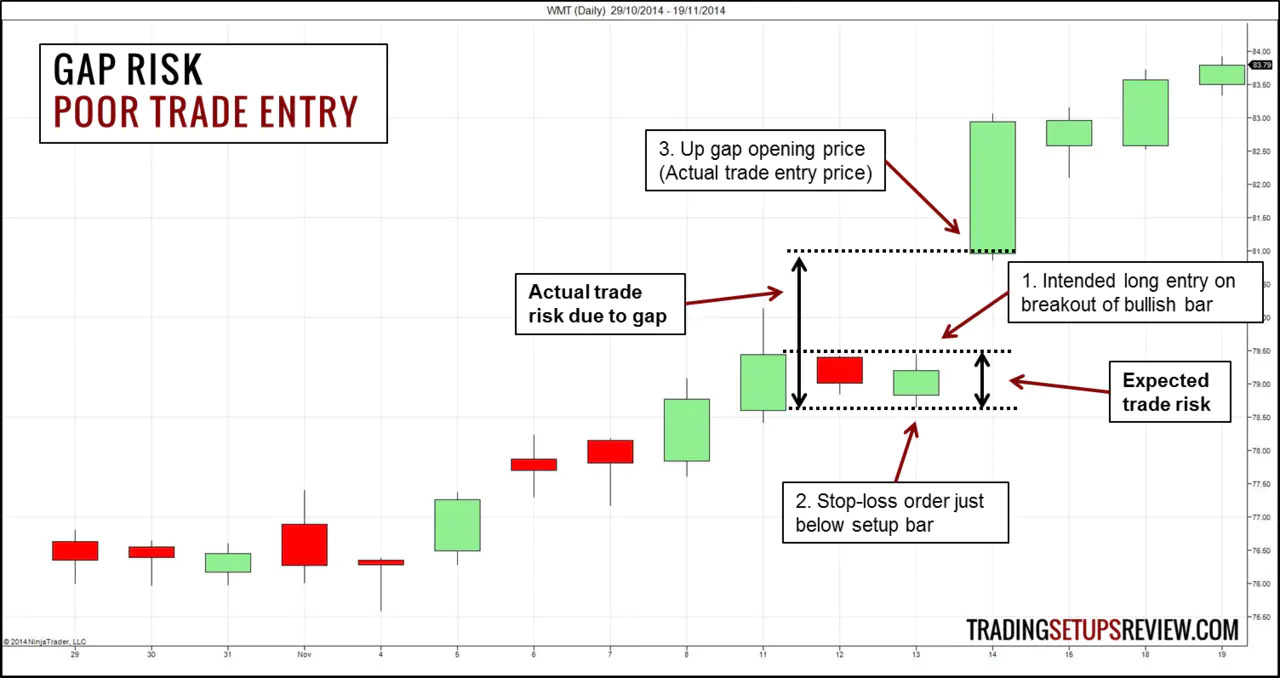How to Manage Gap Risk in Swing Trading
By Galen Woods ‐ 7 min read
Learn how to manage gap risk in swing trading. Don't let a monster gap swallow your hard-earned swing trading profits.
A hallmark of a consistent trader is risk focus. A paradox of trading is that thinking more about risk instead of profits, results in more profits in the long run. For a swing trader holding a position overnight, gap risk is the most challenging risk to manage.
Gaps occur when the market opens away from the closing price of the previous session. It happens because while the market is closed, it continues to discount new material information. Company earnings is a classic example.
Gaps cause a trader to lose control over trade risk in two ways.
- Gap past stop-loss order
- Gap past intended entry price
Let’s discuss them separately and see how you can deal with them.
Gap Past Stop-Loss Order
With a stop-loss order, you know how much you stand to lose for each position. You know the market heat to expect. This is important for position sizing and to manage your emotions.
But with gaps, your stop-loss order is no longer meaningful. The market can gap across your stop-loss order and result in a loss larger than what you expected. The chart below illustrates this scenario.
Ways to Deal with Gap Risk
1. Avoid Holding Positions Before Company Earnings
Earnings are usually announced outside market hours and are certainly material information. Hence, they are a major cause of gaps in stocks.
Unless you are trading your earnings expectations, avoid holding positions just before company earnings. This is a simple step to avoid gap risk.
On Zacks Earnings, there is an “Earnings by Symbol” section. Simply key in the symbol of the stock you intend to swing trade to check if its next earnings date is too close for you.
2. Use Sound Position-Sizing and Diversify
Gap risk represent the possibility that you might lose far more than you expected. (Slippage might also cause you to lose more than expected, but the extent is small compared to gaps.)
Hence, it is critical to size your trading positions conservatively. And never put all your eggs in one basket. No matter how confident you are in a single swing trade, do not devote too much of your trading capital to it. Impose a limit on your trading size in any one trade position.
3. Aim for a Higher Reward-to-Risk Ratio
When the market gaps against you, your trade risk is larger. Your reward-to-risk ratio suffers immediately. But if you take trades with higher reward-to-risk ratio, the enlarged trade risk is less of a problem.
For a trade to enjoy positive expectancy, the following must be true.
Reward-to-Risk Ratio > (1 - W) / W
- W - Winning Probability
For instance, your reward-to-risk ratio is 1. A gap against you causes your risk to double. Your reward-to-risk ratio becomes 0.5. This ratio is too low for positive expectancy unless your trading strategy has an extremely high win rate.
On the other hand, consider a reward-to-risk ratio of 5. In the event that your risk doubles, the ratio falls to 2.5, which requires only a win rate of above 29% to produce positive expectancy.
Hence, trading setups with higher reward-to-risk ratio give us a larger cushion to deal with gap risk.
(To estimate your trade reward, you need to have a method for setting trade targets.)
4. Post-Entry Damage Control
If the market gaps past your stop-loss order, it triggers your order at the opening price of the session. There is not much you can do in those cases.
However, some traders do not use real stop-loss orders. Instead, they have a mental stop-loss which they will enforce manually. If this is how you trade, you can consider the following risk management techniques after a strong gap against you.
Exit part of your position to cut risk. (Never add to your position.)
You sized your position with your initial expectation of trade risk. Now that the gap against you has increased your trade risk, you should exit immediately or at least cut your position size.
Place or tighten your stop-loss based on post-gap price action. This method is ideal for an exhaustion gap. The chart below shows this concept.
5. Buy Options to Limit Your Gap Risk
There are two ways to control gap risk with options.
The first method is to buy an option as an insurance.
If you are in a long position and want to hedge against a bearish gap, buy a put option. If you are in a short position and are afraid of a bullish gap, buy a call option.
In the event of an unfavorable gap, your earnings from the option contract will make up for the loss from the underlying stock. However, the extent of this hedge depends on your choice of the options (expiry and strike).
The second method is to buy a deep in-the-money option contract instead of taking an outright stock position.
Deep in-the-money options offer a way to gain leverage while limiting your risk.
Short-term traders need leverage to amplify trading gains. Most swing traders use margin trading for leverage. They borrow money from their brokers to buy stocks. This means that they might lose more than their trading capital when the market gaps strongly against them.
However, if you swing trade with options, while you enjoy leverage, your loss is also limited to your initial cash outlay.
Sounds too good. What’s the catch?
Unlike stocks, options expire. And when they do expire, they expire worthless. Hence, if you use options for swing trading, you must get both the timing and direction of the stock right. You must choose the right strike and expiry. You also need to pay extra for the time value built into an option contract. Moreover, not all stocks have a liquid options market.
In a nutshell, it’s not easy.
Using options is the surest way to limit your gap risk, as you can only lose the premium you paid despite enjoying leverage. However, it is potentially costly and is more sophisticated. If you want to learn more, start with these books.
6. Trade Markets that Open Round the Clock
A gap is the price difference between a session’s closing price and the next session’s opening. If a market does not close, it trades continuously and will not have significant price gaps. Hence, if you swing trade a market that trades round the clock, you avoid gap risk.
The closest market that trades round the clock is the spot forex market. But even the forex market closes for weekends, and gaps are possible when it reopens on Monday. The same goes for futures that trade almost around the clock like ES and NQ.
In these markets, gaps are still possible but the odds are much lower. Hence, gap risk is limited.
Gap Past Intended Entry Price
You might have planned to buy when the market hits a certain price. That’s your intended entry price. What happens if the market gaps past your entry price?
This chart shows what happens. Your trade risk increases.
Way to Deal with Gap Risk
1. Reduce Your Position Size
When the market gaps past your intended entry price, you can still enter the market. But you must first cut your position size.
As the gap has increased your trade risk, your initial position sizing is invalid. You need to resize your position and enter the market with a smaller amount.
2. Tighten Your Stop-Loss Order
You can also tighten your stop-loss order after the gap. Instead of sticking to the original stop-loss level, you can trail your stop-loss order with the market to limit your risk.
3. Skip the Trade
The first two methods rely on the same criteria.
- Your trading premise/setup must still be valid.
- You can reduce your trade risk to an acceptable level.
If these conditions are not met, do not force a trade. Just skip it and wait for another setup.
Recognize Gap Risk to Manage It
You need to accept gap risk if you decide to hold positions overnight.
Both swing traders and long-term investors hold positions overnight. Investors look at a longer horizon and gaps are blips for them. However, for swing traders, a gap might skew the reward-to-risk ratio of a position and cause expectancy to suffer. Hence, it is critical to manage it.
Many traders are exhilarated when the market gaps in their favor to produce a windfall profit. Yet, they are in denial about what gaps can do when it goes against them.
Recognize gap risk and use the methods discussed above to manage it.
Is gap risk too much for you? Learn day trading to minimize gap risk.




